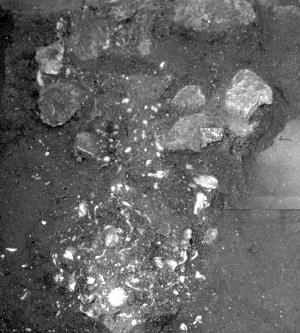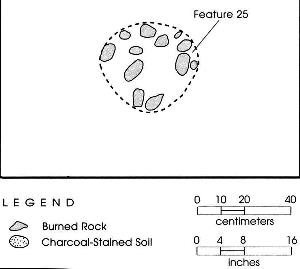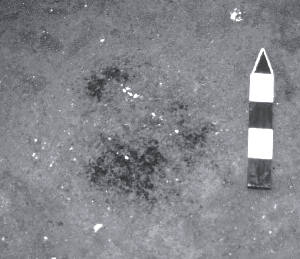Cultural Features
Features are clusters of artifacts or patterns that often represent past activities or individual events such as cooking or dumping trash. For archeologists, patterns of features can help reconstruct human behaviors and group organization, including how a campsite was laid out, size of group, length of stay, etc. Organic materials found within features, such as animal bone or plant remains, can provide insights on diet, food preparation, and types of fuelwood used for fires. Residues such as fatty acids remaining on rocks within some features also can help determine what foods were cooked or prepared within the feature. Charred organic remains often can be radiocarbon dated, helping to establish timing for the occupation(s) of the site.
At the three Bosque River sites, more than 180 features were uncovered, and these were classified into descriptive types. Here we look at examples of the most prevalent types. Additional features are shown in the individual site pages, including a pit unearthed at the McMillan site and areas of burned soil at the Britton site thought to represent a structure.
Basin-shaped Hearths
Basin-shaped hearths are the most prevalent cultural feature type and occur at all three sites. The excavated basin-shaped hearths range from 24x22 to 188x102 cm in size, and 5 to 30 cm in thickness. The basins are always wider than they are deep, and rocks lining the walls are either vertical or generally slope toward the center of the feature. Sometimes a single burned rock layer forming the basin is the only remaining evidence of the hearth, but typically these features are filled with multiple rock layers. Based on ethnographic data and archeological investigations, we believe that many basin-shaped hearths functioned as earth ovens. Earth ovens provided a long-term, constant temperature needed for cooking of many plant foods. Specifically, such long-term cooking is needed for the conversion of complex carbohydrates found in many geophytes (most notably plants with underground bulbs) into edible or more palatable sugars.
Flat Hearths
Forty-five flat hearths were investigated at the three sites. Flat hearths usually have one to two burned rock layers up to 12 cm thick with few sloping, angled rocks suggesting rather quick and simple construction on a minimally prepared or unprepared surface. The largest feature measures 100x80 cm, but most average 50 to 70 cm in diameter. Although organic preservation at the Bosque sites is typically poor, several hearths did contain charred plant remains.
Basins with Sparse or No Burned Rocks
Sixteen virtually rockless basin features were encountered at 41ML37 and 41ML195. Feature dimensions vary from 24x21x13 to 146x120x10 cm, and one partially excavated basin measures 197x63x12 cm. Most basins are composed of mixed ash, charcoal, and burned soil, but in some cases, an ash layer caps a thin lens of oxidized sediment. It is unclear whether the lack of burned rocks reflects removal and possible reuse of the limestone or if the basins are functionally different than other types of hearths.
Discard Piles
Five features at 41ML35 and 41ML37 are classified as discard piles. These consist of discrete deposits of clustered burned rocks associated with nearby features. Discard piles appear to represent cleaning episodes from hearth maintenance or dumps from stone boiling. They typically are one to two layers thick and average 80x70 cm.
Concentrations
Concentration is a catchall term for ill-defined yet isolated groups of burned rocks that do not fit any other burned rock feature type. Eighteen concentrations discovered at the three sites range from 38x12 to 245x154 cm. Most are less than 10 cm thick, consist of one to two burned rock layers resting on a flat surface, and contain few cultural materials. These nebulous features may represent dispersed or disarticulated hearths, cleaning episodes from hearth maintenance, or dumps from stone boiling.
Refuse Dumps
Refuse dumps are present at each site; a total of 15 were documented. Refuse dumps are composed of a mix of cultural and organic remains usually exhibiting irregular edges. Each measures less than 20 cm thick, and three are larger than 100 cm in diameter. Unmodified mussel shells, burned rocks, and ash comprise the more common materials in these features.
Shell Dumps
The only identified faunal feature found at the Bosque River sites consists of dumps of freshwater mussel shells that in some cases are mixed with Rabdotus sp. snail shells. The shells presumably were discarded after the mussels or snails had been eaten. Although dominated by unmodified specimens, the few cut and drilled pieces of mussel shell found within the dumps most likely had been broken during the process of making them into ornaments or other items. In addition, some of the shell dump features included other incidental cultural materials, such as bones or burned rock fragments.
The nine mussel shell dumps at 41ML37 and 41ML195 measure from 33x25 to 190x85 cm. The features exhibit well-defined to irregular edges. Shell counts range from approximately 75 up to 300 specimens per feature, and the dumps vary from one to four shell layers or 3 to 9 cm thick. Copious Rabdotus sp. snail shells in several dumps suggest that these land snails were a viable food source. At 41ML195, three similar mussel shell dumps are directly associated with hearths.
Stains
Eleven stains are characterized by discolored sediment (usually a darker fill than the surrounding matrix), charcoal, and burned soil. They tend to be less than 50 cm in diameter and 10 cm thick; can exhibit distinct to blurred edges in plan view; and display basin, flat, or irregular cross-section profiles. Disturbances, such as burrowing by animals, is evident in a few stains, and some of these features may be natural rather than cultural in origin.
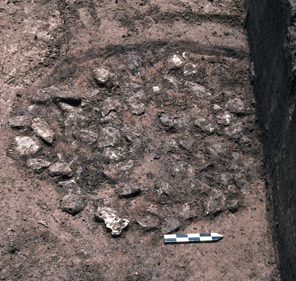
|
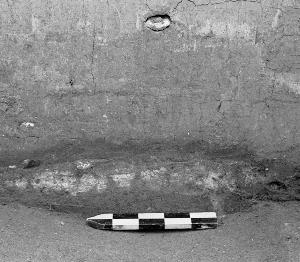
|
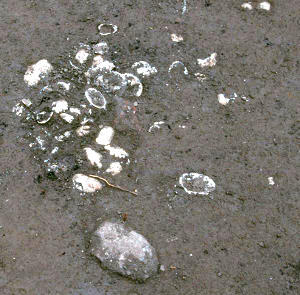
|

